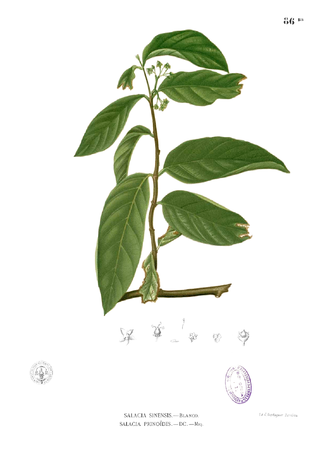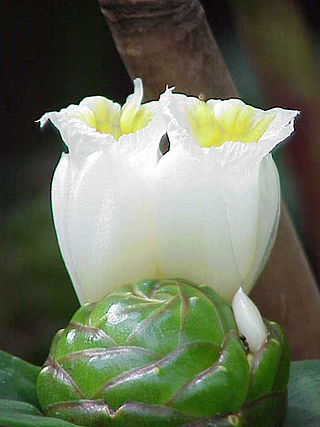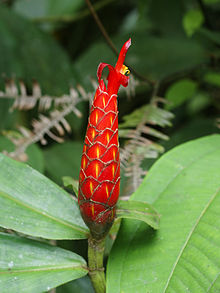
Zingiberaceae or the ginger family is a family of flowering plants made up of about 50 genera with a total of about 1600 known species of aromatic perennial herbs with creeping horizontal or tuberous rhizomes distributed throughout tropical Africa, Asia, and the Americas. Many of the family's species are important ornamental, spice, or medicinal plants. Ornamental genera include the shell gingers (Alpinia), Siam or summer tulip, Globba, ginger lily (Hedychium), Kaempferia, torch-ginger Etlingera elatior, Renealmia, and ginger (Zingiber). Spices include ginger (Zingiber), galangal or Thai ginger, melegueta pepper, myoga, korarima, turmeric (Curcuma), and cardamom.

Alpinia is a genus of flowering plants in the ginger family, Zingiberaceae. Species are native to Asia, Australia, and the Pacific Islands, where they occur in tropical and subtropical climates. Several species are cultivated as ornamental plants.

Zingiber is a genus of flowering plants in the family Zingiberaceae. It is native to Southeast Asia, especially in Thailand, China, the Indian Subcontinent, and New Guinea. It contains the true gingers, plants grown the world over for their culinary value. The most well known species are Z. officinale and Z. mioga, two garden gingers.

Amomum is a genus of plants containing about 111 species native to China, the Indian subcontinent, Southeast Asia, New Guinea, and Queensland. It includes several species of cardamom. Plants of this genus are remarkable for their pungency and aromatic properties.

Costaceae, known as the Costus family or spiral gingers, is a family of pantropical monocots. It belongs to the order Zingiberales, which contains horticulturally and economically important plants such as the banana (Musaceae), bird-of-paradise (Strelitziaceae), and edible ginger (Zingiberaceae). The seven genera in Costaceae together contain about 143 known species. They are native to tropical climates of Asia, Africa, Central America, and South America. Several species are frequently found in cultivation.
Mapania is a genus of plants in the family Cyperaceae. It contains 100 species, distributed in tropical regions of Africa, India, southern China, Southeast Asia, New Guinea, Australia, Central America, northern South America, and various oceanic islands.

Renealmia is a plant genus in the family Zingiberaceae. Its members are native to tropical Africa and tropical America. In Peru, fruits and tubers are sources of indigenous dyes. and indigenous medical treatments for leishmania and malaria In Colombia, it is used to treat snakebite. Bracts and leaves can serve as phytotelmata, retaining small quantities of water that offer habitat for other organisms.

Salacia is a genus of plants in the family Celastraceae. They are woody climbers naturally found in tropical regions.

Costus osae is a species of flowering plant in the family Costaceae. One of many rare tropical plants in the Costus family, Costus osae is a species native to Costa Rica described in 1997. It has also been reported from Colombia.

Costus spicatus, also known as spiked spiralflag ginger or Indian head ginger, is a species of herbaceous plant in the Costaceae family.

Phrynium is a genus of flowering plants native to China, India, Southeast Asia, New Guinea and Melanesia. It was described as a genus in 1797.

Tapeinochilos is a group of plants in the Costaceae described as a genus in 1869. It is native to Queensland, Papuasia, and the Indonesian Province of Maluku. Centered in Papua New Guinea, only three of the approximately 16 species occur outside of the country.
Costus curvibracteatus is a tropical rhizomatous perennial native to Costa Rica and Panama.

Costus malortieanus, known as Stepladder Plant, Spiral Ginger, or Spiral Flag, is a species of perennial herbaceous flowering plant in the family Costaceae. It is native to Costa Rica, Nicaragua and Honduras. Costus malortieanus is often cultivated as an ornamental plant.

Costus dubius is a species of plant native to Tropical Africa.

Costus lucanusianus is a species of plant native to Africa. It is widely distributed across North East Africa, West Africa, Central Africa, East Africa, and Southern Tropical Africa.

Costus comosus, known as red tower ginger, is a species of plant native to South Mexico to Ecuador.

Costus afer, English ginger lily or common ginger lily, is a species of plant native to Tropical Africa.
Costus scaber is a species of plant in the Costaceae family. Its native range is Mexico to Tropical America.

Costus productus, known as orange tulip ginger, dwarf orange ginger, or green mountain spiral flag, is a species of plant in the Costaceae family. Costus productus is native to South Colombia and Peru.





















